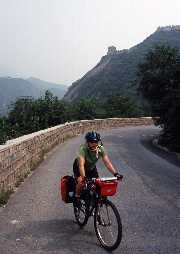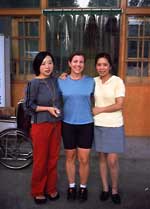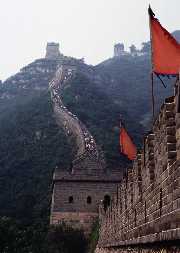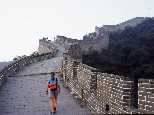You are hereGreat Wall
Great Wall
 We crossed a canal and left the bustling concrete behind. Now we rode
down a tree-lined street, along the canal, around a pagoda-topped peak.
Power lines lined our path. A steady stream of trucks, buses, and cars
honked as they passed us, never too close.
We crossed a canal and left the bustling concrete behind. Now we rode
down a tree-lined street, along the canal, around a pagoda-topped peak.
Power lines lined our path. A steady stream of trucks, buses, and cars
honked as they passed us, never too close.
About five o'clock, we reached the town of Wanquan, listed in our bicycle touring guide as "a possible overnight stop." But there wasn't any lodging here.
The guide, "China by Bicycle," by Ron Griggs, had a great phrase section, containing all the essential bicycle touring phrases missing from our other phrasebooks: "Where should I store my bicycle?" "Can we bring our bikes into our room?" "Can you please fill my water bottle with cool boiled water?" But its route-finding section consisted of merely explaining how to calibrate your bicycle computer so you could follow the tours in the book. And the tours in the book were not fully researched, as we found at our "possible overnight stop," and totally outdated in the four years since publication.
So as we pointed to the phrase "Can you please point to the nearest lodging?," the locals pointed back to Beijing. Uh, oh.
We decided to at least eat something and maybe we could find someone who knew of a place. Stopping at a dumpling house, we had our first confusing ordering experience. We ordered a little Chinese cabbage, and pork dumplings. Out of the kitchen came a huge tray of dumplings, perhaps 30 of them arranged on a 16" steamer. They melted in our mouths, exquisitely succulent.
Then came another tray, the same size. "No," I said. "We didn't order two." They held their fingers up--four. "No," I said. There was no way we could possibly eat four of these trays. The guy at the table next to us started explaining in a heated voice, and we began to wonder if we were going to get in a fight over this.

Then I got it. They were saying "si kuai," four Yuan, or about 50 cents. Not four trays. Laughing at our misunderstanding, we were good friends by the time we left, and the teenage waitress asked to take our picture.
As we left Wanquan, the sun hovered above the western ridge, muted and barely visible through the thick Asian haze. This haze stayed with us through much of the trip. Many of the pictures I've seen in China have this haze, and we wondered if it ever left.
We rode north, away from Beijing, hoping to find a guesthouse somewhere along the way. The sun fell, and suddenly it was dark. We rode along the country road with dozens of other bicycles, workers heading home after a full day in the fields.
One guy wove towards us, saying in good English, "Hello, can I help you?" He told us the next guesthouse was 15 km ahead, in his town of Yangfang. "Oh, wait. I live there. There isn't a place there. No, the next guesthouse is in Nankou, 15 km farther." That's 25km we had to go in the dark.
Past Yangfang, the traffic picked up as another road joined us. Big military transports rolled by. The darkness was thick, but the shoulder was wide and we picked our way up the road. Passing a golf course, we considered stopping and bivying out, but it was a bit chilly.
Finally we reached an intersection. "North China International Shooting Range" read the sign. Soldiers in camouflage toting machine guns guarded the turn. They ignored us as we went the other way, into the suddenly busy, crowded town of Nankou.
The next morning, the road suddenly steepened. Nankou was at the edge of the mountains. We hadn't climbed a hill yet in China, but now the rules of bicycle touring took hold--90% of the time climbing, 10% descending. All of the traffic, however, was on the big new expressway that led straight to the Great Wall at Badaling. The old road we traveled had the odd wagon, tractor, or pickup truck with a load of coal. We passed people pushing their bikes up the hill, and each time they sputtered in surprise as we went by.
After passing a toll gate on the freeway, we no longer saw any bikes. We kept climbing and climbing--a fairly gentle grade, mostly--but nonstop.
 And
then we saw it. A lot sooner than we thought, the light brown wall
lined the top of a ridge, snaked down a spur to the road. We passed a
couple resorts, climbed a couple of windy stretches, and then we were
there. Not that we knew where "there" was. Juyongguan pass. Not the
"Great Wall," but close enough for now.
And
then we saw it. A lot sooner than we thought, the light brown wall
lined the top of a ridge, snaked down a spur to the road. We passed a
couple resorts, climbed a couple of windy stretches, and then we were
there. Not that we knew where "there" was. Juyongguan pass. Not the
"Great Wall," but close enough for now.
The Great Wall is a myth, really. You hear all sorts of misinformation about it--that it's the only human building visible from the moon, that it's one single, continuous wall, that it was all built around the same time to keep the Mongols out of China. The hordes of Chinese and foreign tourists buy into the myth whole-heartedly. But the actual history of the wall is more interesting than the myth.
For starters, it's not continuous, and it never has been. Segments were built here and there in particularly vulnerable valleys, and across startlingly imposing ridges. But the Mongols went around the segments easily, pillaging the Ming countryside at their leisure. The wall at Juyongguan parallels the Great wall, about 12 km closer to Beijing, and was built a few decades later. It's steeper, narrower, and in some ways more photogenic than the wall at Badaling.
Until recently, the Great Wall was a European myth--early travelers saw segments of the walls in different areas and assumed it was continuous, creating the myth. In the Cultural Revolution, in fact, the Chinese government took great pains to destroy large areas of the already ruined wall. But now, suddenly it's the national symbol, and much has been reconstructed. One of the surprising things about the wall is its newness.
We climbed the eastern section at Juyongguan until it started downhill again, getting quite worn out in the process...
 It
took another couple hours to ride up to Badaling, the most visited site
on the Great Wall. Compared to Juyongguan, the Badaling wall was wide
enough for a formation of soldiers to march along. Our guide book said
that sometimes skateboarding was permitted, though only for the truly
insane. Must be a population control method...
It
took another couple hours to ride up to Badaling, the most visited site
on the Great Wall. Compared to Juyongguan, the Badaling wall was wide
enough for a formation of soldiers to march along. Our guide book said
that sometimes skateboarding was permitted, though only for the truly
insane. Must be a population control method...
More to come...
